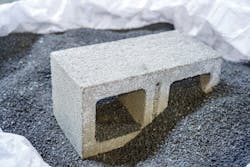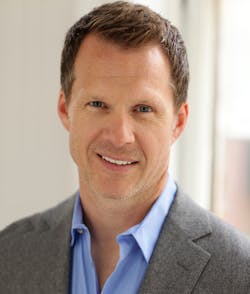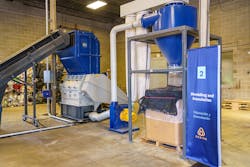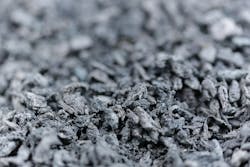From the summer 2023 issue of Plastics Recycling.
By Ron Shinn
There have been attempts in the past to add plastic waste to traditional building products, but it turns out that shredding the material and dumping it into concrete or asphalt does not work for most applications because plastic waste repels water and cannot bond with those materials.
That might have changed with a patented new product called Resin8. The Center for Regenerative Design and Collaboration, known as CRDC Global, has developed a process that allows plastic waste to bond with concrete and asphalt, and it now has two plants — one in Costa Rica and a newer one in York, Pennsylvania — recycling plastic categories 1 through 7 for use as an additive to concrete blocks and pavers, pre-cast concrete, ready-mix concrete, and mortar and hot-mix asphalt.
“We are excited about the possibilities,” said Ross Gibby, chief operating officer of CRDC Global and president of CRDC USA. “Our process is very locally focused. We envision each one of our locations serving a maximum area of about 300-mile radius.”
He said the York plant, which opened in October, is being designed in modular units. “Our goal in York is to get it to a point where it is templated so that when we do move into a new market, we can just sort of deploy our team, get our machinery and execute the plan. It is a little bit of an out-of-the-box solution.”
Inspiration on a beach
The origin of Resin8 can be traced back to children picking up plastic waste every morning on a beach in Costa Rica.
Canadian businessman Donald Thomson, a materials scientist and innovator, was a young man working in the concrete industry in Costa Rica when he designed and patented a lightweight, tilt-up, insulated concrete wall system. He formed and eventually sold a company based on that product.
He decided to stay in Costa Rica and moved away from continuing with concrete innovations, focusing instead on development of affordable housing and resort properties. He eventually owned a resort and saw that every day, more plastic washed up on the beach.
First, he recruited local children to help him pick up plastic waste every morning, but the volume of plastic became overwhelming.
Next, he decided to develop ways to turn the waste plastic into useful products. He started with a plastic water bottle that could be folded into a roofing tile when discarded, but even though the product won international awards, Thomson realized that converting one water bottle into one roof tile would not solve the bigger plastic pollution problem. So, he sold the water bottle company and started working on projects that could be more easily scaled.
“He decided to attack the problem from the concrete and construction side, not from the plastic or environmental side,” Gibby said. “He wasn’t looking for a way to hide plastics. He was looking for a way to improve the construction industry and use a very abundant waste stream to do it.”
Perfecting the process
Thomson founded CRDC Global in 2018 and spent a few years developing a procedure that lets mixed waste plastic bond with concrete and asphalt. First, he shredded and granulated the waste plastic, then mixed it with calcium hydroxide and ash before extruding the mixture. Then he granulated it again to produce a final product that CRDC Global calls a hybrid mineral polymer — 80 percent plastic and 20 percent mineral additives. It is added to masonry products or asphalt.The plastic is not wet washed. Instead, the mineral additives provide a dry wash that sanitizes the plastic and removes odors. There is no waste from the plant.
“We can accept the full waste stream, including contamination like food waste, sand off beaches and algae from rivers,” Gibby said. “We transform it into this material that is no longer just plastic.”
“It has a very rough surface and an open cell structure,” Gibby said. “It maintains that open cell structure when we granulate it. It has irregularities that expose those mineral additives. When it gets integrated into a concrete matrix, the cement paste permeates into all those little cavities. It is able to bond to the rough facial surfaces, and then exposure of those two mineral additives has a bit of chemical bond.
“That’s where we get the strength of Resin8.” Just adding plastic to concrete does not provide the strength needed for structural applications.
Gibby said Resin8 looks like construction sand or limestone. It is one-fourth the weight of the aggregate material it replaces, such as sand, and reduces water absorption of the finished product, which is important in climates that have freeze-thaw cycles. It also has an insulation R-value that is almost three times higher than sand and offers fire resistance when added to concrete.
“When it goes into a building, Resin8 can reduce energy usage of that building over time,” Gibby said.
At the opening ceremony for the 14,000-square-foot York plant, Thomson, who serves as CEO of CRDC Global, said, “While we are helping to clean up plastic waste, we’re also providing a product that stands on its own in terms of performance and commercial viability. Resin8 has a positive impact on both the plastics and the construction industries as a functional example of zero waste.”
Finding the right equipment
CRDC Global shopped for processing equipment in both Europe and the U.S. in 2019 but ended up working with a Chinese manufacturer of mechanical recycling machinery to customize equipment for CRDC Global’s specific needs.“We are producing a material that is very unrefined. It’s ugly,” Gibby said. “It’s a big chunk of plastic that looks like a lava rock, and the European and U.S. equipment is designed to produce a very clean, very detailed plastic product or pellet. The European and U.S. equipment was over-engineered for our need.”
Gibby also said the European machinery manufacturers needed 12 months to deliver one new system and the Chinese manufacturer could deliver 12 machines in 45 days. He said the ability for CRDC Global to expand quickly across the world was important when selecting equipment.
The York plant is already shipping Resin8 to more than 10 companies and others in the U.S. and Canada that need to test the new material before it can be incorporated into their masonry products.
It has one shift with six employees working in the York plant. Since accounting and other administrative functions are handled by CRDC Global, Gibby said maximum employment at the plant would be about 20 when it is operating three shifts.
The York plant is still in the scale-up phase, and Gibby said that by later this summer it is scheduled to be capable of producing about 1.5 tons of Resin8 per hour. “We have a few projects in the pipeline that should be initiated in the next 2-3 months,” Gibby said when asked where the additional Resin8 material would be sold.
The road forward
Resin8 produced at York is targeted for concrete building products such as blocks and pavers, and as an additive to ready-mixed concrete. A typical application might replace up to 10 percent of the traditional aggregate in a concrete product.
Gibby said using it in asphalt will not initially be a primary target. CRDC Global has successful test projects in Costa Rica using Resin8 as an asphalt additive, but obtaining individual state approvals for U.S. projects would be a time-consuming task, he said.In addition to the original production facility in Costa Rica and the newer York plant, CRDC Global has pilot plants in South Africa, the U.K., Mexico, Australia, New Zealand, Samoa and Hong Kong. CRDC Global is working with London-based PA Consulting to find new markets and scale up production worldwide.
Because it accepts plastic in categories 3 through 7, Gibby said raw material has been pouring in. “As soon as you get some press that says you are accepting 3 through 7s, it comes out of the woodwork,” he said. “It’s amazing how many people call and ask us to take their plastic.”
Gibby said the plant is currently receiving shipments from MRFs and other collection agencies all over the country that are accumulating plastics they cannot recycle, but he expects the shipments will become more local once additional processing plants are built. Some manufacturers that take back products such as printer ink containers that cannot be recycled are also sending their material to York.
CRDC Global also furnishes bags for a local program that lets residents drop off their plastic waste.
The Alliance to End Plastic Waste, a major funding partner for CRDC Global, describes Resin8 as an example of a technology that unlocks the value of plastic waste and that can be replicated globally.
Two virgin resin manufacturers, Braskem and Dow, are active in the Alliance. Both chemical companies are working with CRDC Global to get Resin8 into new markets.
Braskem in 2020 used concrete blocks containing Resin8 to build a 15-foot wall in an expansion of its technical center in Pittsburgh. It was the first use of Resin8 in the U.S. Habitat for Humanity used Resin8 in building 200 homes in Costa Rica.
Ron Shinn, editor
About the Author
Ron Shinn
Editor
Editor Ron Shinn is a co-founder of Plastics Machinery & Manufacturing and has been covering the plastics industry for more than 35 years. He leads the editorial team, directs coverage and sets the editorial calendar. He also writes features, including the Talking Points column and On the Factory Floor, and covers recycling and sustainability for PMM and Plastics Recycling.




